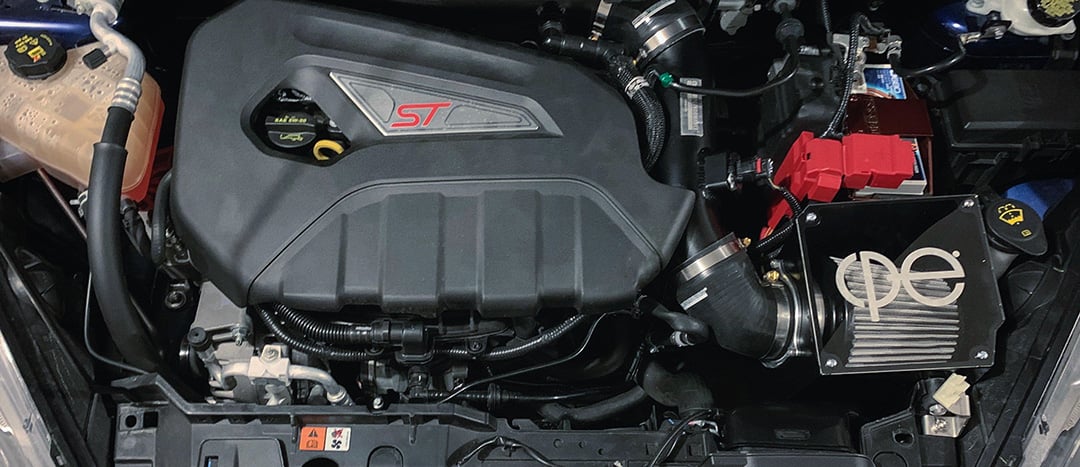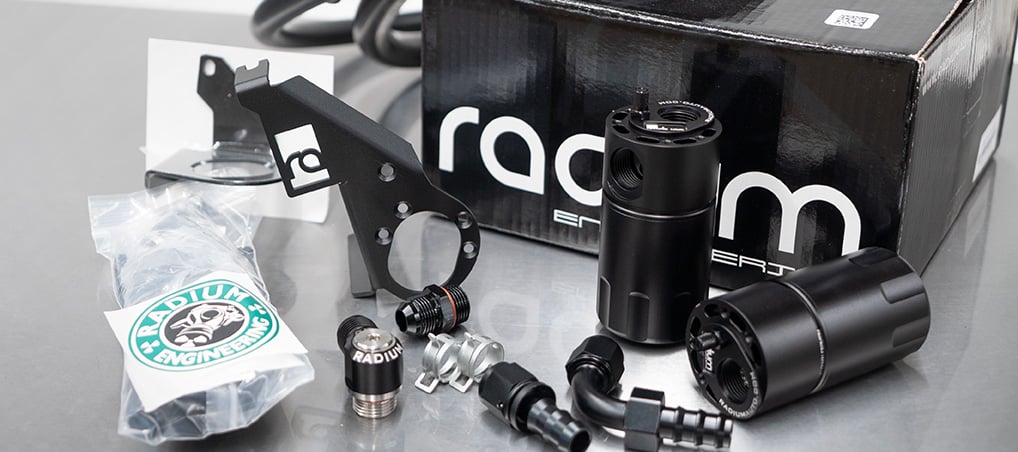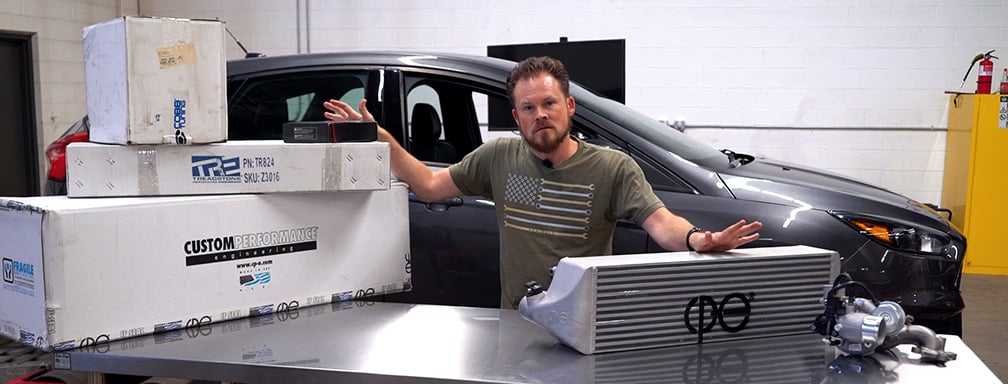Focus ST EWG (External Wastegate) - Does Your Big Turbo Need It?
January 31st, 2024
7 min read
By JP Alonso
%20-%20Does%20Your%20Big%20Turbo%20Need%20It/EWGKit-web-(2).jpg?width=1018&height=449&name=EWGKit-web-(2).jpg)
When ATP Turbo first released their Garrett based bolt-on turbo kits back in 2013-ish for the Ford Focus ST, they started by including a port in the turbine housing casting that allowed the user to add an external wastegate (from now on, we'll refer to it as EWG). If you don't know by now, this is pretty awesome. Here's a little bit about why, along with some information about if it's a good option for you and your big turbo Focus ST.
|
What we'll cover: |
What is an EWG?
If you already know what an EWG is and know about how the turbo on the ST is configured, by all means, skip ahead. We're covering the basics for a broad audience here.
In almost every turbocharged vehicle, a wastegate is a feature that exists as the primary method to control boost. This is a valve that allows exhaust pressure to bypass around the turbine wheel (exhaust side of turbo), thereby limiting the amount of exhaust that actually hits the turbine wheel, which would result in higher turbo speeds and produce higher pressure in the intake (more boost). Virtually every turbocharged vehicle of similar nature as the Focus ST features an OEM turbo with an internal wastegate (IWG). Almost all of the bolt-on big turbo upgrades for Focus ST feature this type of wastegate also. That's part of what makes it "bolt-on". For Focus ST's with a bigger turbo, it is an upgrade to replace this built-in version with one that relocates it outside of the turbo, hence the name external wastegate. The valve is external of the turbo itself, somewhere in the exhaust stream between the cylinder head and the turbo.
In traditional exhaust manifolds where you have a stand alone part that collects the exhaust from each cylinder and transfers it to the turbo (unlike the ST), an EWG is typically placed in the collector area of the manifold, right before entering the turbo. The exhaust sent through the wastegate reroutes through a small tube either outside of the vehicle to the atmosphere or back into the standard exhaust pipe directly downstream of the turbine housing to join the exhaust that actually did travel through the turbine, and ultimately out of the tail pipe.%20-%20Does%20Your%20Big%20Turbo%20Need%20It/Collector%20with%20EWG.webp?width=500&height=332&name=Collector%20with%20EWG.webp)
In the Focus ST, there is no standalone exhaust manifold. The exhaust runners are cast directly into the cylinder head and collect at the edge of the head to transition straight into the turbo. This is getting more and more popular with OEM car makers these days. This means an EWG must be placed in the small area between the head and the turbo. In the case of the ATP Turbo kits, this is a part of the casting they designed that connects the head to the turbo. This is typically referred to as the turbo or manifold "elbow".
%20-%20Does%20Your%20Big%20Turbo%20Need%20It/Traditional%20vs%20Single%20Port%20Exhaust%20Head.jpeg?width=780&height=519&name=Traditional%20vs%20Single%20Port%20Exhaust%20Head.jpeg)
YOU KNOW WHAT IT IS AND HOW IT WORKS. BUT IS IT REALLY WORTH THE MONEY?
Let's face it, if your turbo comes with the IWG already, you can more than likely use it without worry in almost all cases. Most people won't actually need an EWG. On top of that, you're spending over $500 for it. So why get it?
Before we fully dive in, it's important to understand why we're specifically talking about ATP Turbo kits here compared to some others. There are other turbo kits on the market that we also offer, but they don't quite match up to how the ATP is configured. I mentioned earlier that the ATP kits come with a port to expand to an EWG from the original IWG configuration. In some cases, like the G-Series based turbo kits, they only come with the ability to run EWG so it doesn't even matter if you want it or not, you're forced to use it. No other kits feature this exact functionality. Other turbo kits like the cp-e Atmosphere kit or some other Precision based kits out there already come with external wastegates but they're far less popular and not the same level of "bolt-on". The Mountune and BNR kits don't come with the expandable port like the ATP and you must use the IWG they come with. I'll say now the IWG in the Borgwarner EFR based Mountune kits are legit. They are larger than the average IWG port and they are more inline with the flow of the exhaust, helping them flow better. They work really well. Regardless, ATP is by far the most popular turbo kit on the market so this will apply to a large number of upgraded Focus STs on the road both now and in the future, most likely.
%20-%20Does%20Your%20Big%20Turbo%20Need%20It/ATP%20Turbo%20Kit%20-%20Focus%20ST%20-%20EWG%20vs%20IWG%20Port.png?width=720&height=720&name=ATP%20Turbo%20Kit%20-%20Focus%20ST%20-%20EWG%20vs%20IWG%20Port.png)
5 Reasons for Upgrading to an EWG
1. Boost control and response
The turbo elbow is designed to use the relatively small 38mm Tial wastegates or the 40mm Turbosmart units. Although these are on the small end of the aftermarket performance spectrum, they are ridiculously larger than the space constricted IWG port that measures only 24mm (less than 1 inch). Naturally, this means the area where exhaust pressure is flowing through is more efficient and just flows more exhaust at any given pressure and velocity. In addition to higher flow, the valve on these EWGs lifts vertically away from it's seat, meaning the exhaust can flow around the entire circumference of the valve and into the housing where it dumps out the side with a large opening. On the IWG, the valve is a swing arm style where the door pulls away from the passage at an angle. This means that upon opening, the exhaust can only escape at a low rate until the door really starts to move off of the back side of the hole, allowing exhaust to flow fully through.
%20-%20Does%20Your%20Big%20Turbo%20Need%20It/ATP%20Turbo%20IWG%20Port%20Diameter%20-%20Focus%20ST.jpg?width=850&height=680&name=ATP%20Turbo%20IWG%20Port%20Diameter%20-%20Focus%20ST.jpg)
ATP Turbo IWG Port - 24mm |
%20-%20Does%20Your%20Big%20Turbo%20Need%20It/EWG%20Dump%20Tube%20ID%20Diameter.jpg?width=749&height=599&name=EWG%20Dump%20Tube%20ID%20Diameter.jpg)
ATP Turbo EWG Outlet Port - ~34mm ID |
These differences allow the boost pressure to respond quicker to input and avoid such large swings and oscillations in boost where changes in boost pressure lag far behind when the computer tells it to change. This ends up showing up on dyno curves as large peaks and valleys where the turbo is chasing ECU commands and usually ends up overshooting in either direction. This can end up being a very uneven torque curve on bigger turbos that spool up very fast but can't flow enough exhaust through the wastegate to react quickly.
2. More power
When you remove the wastegate controlled gases from the turbine housing entirely, it allows for less turbulence and more efficient flow for the exhaust going through the turbo. Eliminating the collision of the wastegate gases and turbine gases at the back side of the turbine wheel promotes more efficiency, reducing back pressure and turbulence. You might not ever notice this because turbos have a magical way of hiding inefficiencies by just "throwing more boost at it". But that doesn't change what's physically happening. If you asked me which setup I wanted between two cars making exactly the same power and one doing it with 2 psi less boost, I'll take the latter.
3. Running low boost
When you think about it, a larger wastegate is better for running lower boost levels too. Let's pretend you want 18psi out of your turbo that's capable of 35psi. That little hole will not flow enough exhaust to prevent it from creeping past 18psi. The larger compressor wheel is flowing a lot of air, causing a lot of exhaust. That exhaust has to go somewhere and if you're trying to divide it efficiently, both areas must have room to flow. This isn't as big of a deal with the ST because it need lots of boost to make power. But what if you have a valet map that lowers boost to spring pressure? You want it to be able to hit that target.
4. Added functionality creates reliability and flexibility
A high quality EWG usually features more than what the IWG can provide. Cooling ports allow you to run coolant through the diaphragm section which aids in reliability, keeping the wastegate functional for longer and reduces the possibility of damage to any internal components. Additional air ports allow you to plumb more vacuum lines to the diaphragm in more locations, instead of a fixed position canister of an IWG. Various springs allow you to run a different base boost pressure, which is where the wastegate would start opening without the assistance of a boost controller. The ATP kit comes with a 12psi IWG spring and all other inefficiencies aside, the general rule of thumb is that you can only achieve about 100% more boost than the base boost pressure of the wastegate base pressure. This means about 24psi in this case. Upgrading to an EWG and using a base boost pressure of 18psi, for example, extends your boost ceiling significantly. At the least, it just allows the 3 port boost controller to function within a wider range instead of being maxed out trying to hold the wastegate closed. Realistically, you're not buying a bigger turbo for a Focus ST to only run 18psi, so you'll probably never go below that in any of the ATP kits, anyway.
%20-%20Does%20Your%20Big%20Turbo%20Need%20It/Turbosmart%20EWG.jpeg?width=1080&height=608&name=Turbosmart%20EWG.jpeg)
5. Cool factor
EWG's can be plumbed 1 of 2 ways. You can send the exhaust gases to the atmosphere, or you can reroute them downstream of the turbo which is functioning just like stock and sending all exhaust out of the tail pipe. The cool factor is definitely on the side of the atmospheric exit. The dump tube, or the exhaust pipe for the wastegate, is also commonly referred to as a screamer pipe. When your car hits its desired boost level, the wastegate opens and a very distinct exhaust sound is released. It's not like how it sounds at the tail pipe where it had time to bounce around the exhaust piping, resonator, and mufflers before exiting. It's coming straight out of the engine and through the wastegate. Every car is different but the Focus ST puts out a fairly mild "scream" and for those that enjoy turbo and exhaust noises, you'll have some fun with it.
The Downside of the ATP Kit
Most of what I've discussed about upgrading the EWG pretty much applies to all EWG setups when compared to IWG. There is nothing inherently different about how it works on a Focus ST. However, the ATP kit is designed to be as "bolt-on" as possible and with that said, sometimes compromises in functionality are made in order to achieve convenience and fitment. The EWG port on the ATP turbo elbow is basically facing the opposite direction that it should. Ideally, an EWG should receive exhaust flow at an angle of about 45° or less so that the exhaust doesn't have to slow down or bend too much, causing turbulence and slowing down the exhaust velocity. However, this EWG system is not being compared to a different EWG system. We're strictly making the comparison of this kit to the IWG. With that said, it still works better. Based on our experience tuning with these kits hundreds of times over, we've found they flow really well and allow us to control boost more accurately
and consistently than the IWG.
%20-%20Does%20Your%20Big%20Turbo%20Need%20It/Garrett%20Wastegate%20Flow%20Angle%20Recommendation.png?width=1080&height=608&name=Garrett%20Wastegate%20Flow%20Angle%20Recommendation.png)
What parts do you need to run an EWG?
ATP Turbo has plenty to choose from when selecting one of their Garrett based kits. The majority of them come standard with an IWG setup. However, a few don't. The IWG port is blocked off in the casting process and they require you to use the EWG port. The blocked IWG is standard on the G25 and G30 kits and is available as an option for the GTX2867, 3071, and 3076 Gen2 turbos.
%20-%20Does%20Your%20Big%20Turbo%20Need%20It/3P%20Performance%20EWG%20Kit%20Components.jpeg?width=1080&height=608&name=3P%20Performance%20EWG%20Kit%20Components.jpeg)
You'll need a Tial MV-S 38mm or Turbosmart CompGate 40mm to mate to the EWG port. You'll need a dump tube. We offer a very nice, custom built tube made by 3P Performance that we actually collaborated with them on and is exclusively available through us. It's TIG welded, 304 stainless steel, and beautiful. If you already had an IWG turbo and are converting to EWG, you need to block that IWG port. The easiest way is by replacing the wastegate actuator assembly with a solid bracket that holds the wastegate shut. A few brands make this and we include it in the EWG kit we offer. If you have a non-IWG housing, you do not need this as there is nothing to block off.
Ready to get going on your search for a turbo kit or expand your current ATP kit with an EWG setup?
I'm the founder of Edge Autosport and I remember first getting into cars in high school. I read all the magazines, bought a bunch of technical books, and finally got to start wrenching around the age of 19. I really enjoy modding and being able to live out a passion is truly awesome. I wouldn't change a thing.
Topics:
%20-%20Does%20Your%20Big%20Turbo%20Need%20It/3P%20EWG%20Kit%20Focus%20ST%20Shop%20Now%20Banner%20(2).jpeg?width=900&height=175&name=3P%20EWG%20Kit%20Focus%20ST%20Shop%20Now%20Banner%20(2).jpeg)





.jpg?width=1024&height=299&name=Putting%20Down%20400whp%20In%20Your%20Focus%20ST%20(2.1).jpg)









